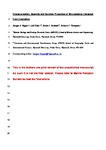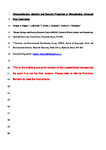Characterisation, Quantity and Sorptive Properties of Microplastics Extracted From Cosmetics
| dc.contributor.author | Napper, IE | |
| dc.contributor.author | Bakir, A | |
| dc.contributor.author | Rowland, Steven | |
| dc.contributor.author | Thompson, Richard | |
| dc.date.accessioned | 2015-07-30T09:03:07Z | |
| dc.date.available | 2015-07-30T09:03:07Z | |
| dc.date.issued | 2015-10-15 | |
| dc.identifier.issn | 0025-326X | |
| dc.identifier.issn | 1879-3363 | |
| dc.identifier.uri | http://hdl.handle.net/10026.1/3502 | |
| dc.description | Pre-print file replaced (incorrect version) on 16/9/2022 by KT (LDS). | |
| dc.description.abstract |
Cosmetic products, such as facial scrubs, have been identified as potentially important primary sources of microplastics to the marine environment. This study characterises, quantifies and then investigates the sorptive properties of plastic microbeads that are used as exfoliants in cosmetics. Polyethylene microbeads were extracted from several products, and shown to have a wide size range (mean diameters between 164 to 327 μm). We estimated that between 4594 – 94500 microbeads could be released in a single use. To examine the potential for microbeads to accumulate and transport chemicals they were exposed to a binary mixture of 3H-phenanthrene and 14C-DDT in seawater. The potential for transport of sorbed chemicals by microbeads was broadly similar to that of polythene (PE) particles used in previous sorption studies. In conclusion, cosmetic exfoliants are a potentially important, yet preventable source of microplastic contamination in the marine environment. | |
| dc.format.extent | 178-185 | |
| dc.format.medium | Print-Electronic | |
| dc.language | en | |
| dc.language.iso | en | |
| dc.publisher | Elsevier | |
| dc.subject | Microplastic | |
| dc.subject | Exfoliating microbeads | |
| dc.subject | Polyethylene | |
| dc.subject | Ocean pollution | |
| dc.subject | Contaminant | |
| dc.title | Characterisation, Quantity and Sorptive Properties of Microplastics Extracted From Cosmetics | |
| dc.type | journal-article | |
| dc.type | Article | |
| plymouth.author-url | https://www.webofscience.com/api/gateway?GWVersion=2&SrcApp=PARTNER_APP&SrcAuth=LinksAMR&KeyUT=WOS:000364258000031&DestLinkType=FullRecord&DestApp=ALL_WOS&UsrCustomerID=11bb513d99f797142bcfeffcc58ea008 | |
| plymouth.issue | 1-2 | |
| plymouth.volume | 99 | |
| plymouth.publisher-url | http://www.journals.elsevier.com/marine-pollution-bulletin/ | |
| plymouth.publication-status | Published | |
| plymouth.journal | Marine Pollution Bulletin | |
| dc.identifier.doi | 10.1016/j.marpolbul.2015.07.029 | |
| plymouth.organisational-group | /Plymouth | |
| plymouth.organisational-group | /Plymouth/Faculty of Science and Engineering | |
| plymouth.organisational-group | /Plymouth/Faculty of Science and Engineering/School of Biological and Marine Sciences | |
| plymouth.organisational-group | /Plymouth/REF 2021 Researchers by UoA | |
| plymouth.organisational-group | /Plymouth/REF 2021 Researchers by UoA/UoA07 Earth Systems and Environmental Sciences | |
| plymouth.organisational-group | /Plymouth/Research Groups | |
| plymouth.organisational-group | /Plymouth/Research Groups/Marine Institute | |
| plymouth.organisational-group | /Plymouth/Users by role | |
| plymouth.organisational-group | /Plymouth/Users by role/Academics | |
| plymouth.organisational-group | /Plymouth/Users by role/Researchers in ResearchFish submission | |
| dc.publisher.place | England | |
| dcterms.dateAccepted | 2015-07-13 | |
| dc.rights.embargodate | 2017-8-10 | |
| dc.identifier.eissn | 1879-3363 | |
| dc.rights.embargoperiod | Not known | |
| rioxxterms.versionofrecord | 10.1016/j.marpolbul.2015.07.029 | |
| rioxxterms.licenseref.uri | http://www.rioxx.net/licenses/all-rights-reserved | |
| rioxxterms.licenseref.startdate | 2015-10-15 | |
| rioxxterms.type | Journal Article/Review |



